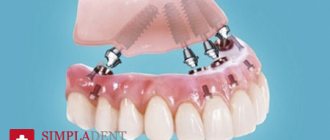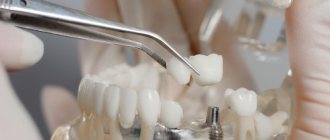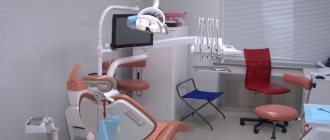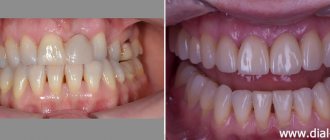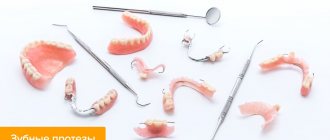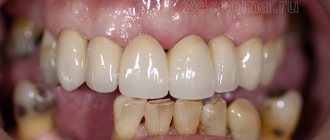Publication date: 03/19/2021
It seems that dental implantation takes a long time and it is impossible to make teeth turnkey in 1 day. However, innovative technologies and modern materials are capable of even this. Restoring lost teeth and making them indistinguishable from real ones is a feasible task for today’s medicine.
A beautiful, attention-grabbing smile is an indicator of health and status. It gives self-confidence to its owner. But what to do if not all the teeth were saved, or most of them are destroyed or are subject to severe caries. In such cases, treatment and subsequent implantation come to the rescue. This way you can get your perfect smile back in 1 day.
Indications and contraindications for installing implants in one day
This type of prosthetics allows you to either restore an entire row of teeth or make a prosthesis for just one tooth. This method is recommended for:
- periodontal disease
- irritation of bone tissue
- receding gums
- complete absence of teeth
This technology allows you to insert teeth in one day and immediately return a beautiful smile and the ability to eat comfortably.
One-time implantation is especially good in cases of complete or almost complete absence of teeth, when there is no time for a long wait and you want to quickly return to a full life.
There are certain situations in which implantation in one day is not possible. A preliminary examination will help identify these indications, without which medical intervention should not begin. Contraindications to dental implantology are:
- advanced osteoporosis
- oncological diseases
- connective tissue pathologies
- poor blood clotting
- immune system disorders
- decompensated diabetes
- acute infectious diseases
- pregnancy and lactation
If the above indications are present, the doctor will recommend an alternative method of restoring the dentition.
How tightly is the prosthesis fixed?
Chewing immediately after implant surgery seems like a fairy tale to patients. Moreover, this prospect frightens many, as there is a fear that the entire structure will become loose.
But the dentures are fixed securely. And this is achieved, firstly, through the selection of special implants - they are designed specifically for these protocols and have a high strength of primary fixation. Such implants compact bone tissue when screwed in, and their surface is coated with bioactive substances that accelerate the growth of new cells. Secondly, they are placed in the bone at an angle - this way they distribute the load over a larger area. Thirdly, the choice of place for implantation also affects the strength - even at the 3D modeling stage, the doctor selects suitable areas of the bone. And finally, the prosthesis itself with a metal base plays the role of a splint - it connects and immobilizes all the implants.
Therefore, chewing does not interfere, but, on the contrary, helps the fusion of implants with the jawbone - pressure and load stimulate the natural growth and renewal of bone tissue cells, almost as if there were living roots in it. That is why, in the case of complete absence of teeth, punctures with the immediate installation of a fixed prosthesis, which rests on implants, are much better than if the implants were left alone until they completely fused with the bone - this process (engraftment or osseointegration) in the second case takes longer, more difficult and less predictable.
Four implants may be sufficient to support a full jaw denture. Photo: Smile-at-Once
Stages of treatment
Implantation in 1 day is prosthetics immediately after the installation of implants. The issue of aesthetic and practical function of teeth is resolved in a short time. This operation does not require bone grafting. Implants can be installed not only in the spongy substance, but also in deeper layers of bone. In addition, the pins can be placed at an angle. This technology allows you to avoid injury to nerves, blood vessels and paranasal sinuses.
The installation of implants is carried out in one visit to the dentist, but to achieve the final result, this procedure requires preparatory measures. The whole operation takes place in several stages:
- At the first session, the doctor conducts diagnostics, determines the current condition of the patient’s teeth, possible contraindications, and performs a computed tomography scan. If preliminary treatment is necessary, it must be carried out. Otherwise, it will not be possible to install new teeth. At the same appointment, a model of future prostheses is created. The waiting period for future implants ranges from 1 to 7 days. Next, the doctor chooses the method of performing the procedure, selects the pins and makes the crowns that will be installed.
- The second stage is the work of installing the metal pins themselves. It is performed under anesthesia in one procedure. At the site where the implants are installed, an incision is made in the gum and pins are screwed into the prepared recess. Then the gum is sutured. Next, a temporary prosthesis is placed on the implanted implants. It is made of acrylic, so it is quite light, which contributes to comfortable wear and rapid healing.
The permanent prosthesis is installed 6-12 months after implantation. This time is enough for the implant to fuse with the bone.
What are the advantages of one-stage implantation?
Firstly, with its help you can close the gap formed due to tooth loss with a reliable and aesthetic design and not be embarrassed about your smile. Secondly, a temporary dental crown immediately installed on the implant allows you to create an ideal gum contour and avoid the appearance of a very common defect during delayed implantation - black triangles - spaces between the artificial tooth and adjacent natural teeth not covered by soft tissue. And thirdly, one-stage implantation reduces treatment time by approximately half.
To attract clients, some clinics often call the one-stage method express implantation and promise to completely restore the patient’s tooth in one day. But you need to understand that during one appointment, the doctor can load the implant only with a temporary crown, and install a permanent one three to four months later. Loading an implant that is not yet fully stabilized in the bone with a fairly heavy permanent structure threatens, firstly, with its rejection, and secondly, with the occurrence of a rather dangerous defect. The fact is that after the operation the soft tissues are very inflamed and fit very tightly to the crown. After some time, the swelling subsides and a gap forms between the gum and the prosthesis, which is closed with a more suitable permanent crown. If you immediately install a permanent structure on the implant, the resulting gap will no longer be able to be closed. After some time, the gums will sink even more and expose the abutment, which will be very noticeable when you smile, and the bacteria accumulating on it will cause inflammation and, as a result, re-implantitis.
Which implantation method is best to use?
In modern dentistry, there are several methods of implantation with immediate loading. The most popular and affordable is all-on-4. With this protocol, the dentition is replaced with only four pins. Two of them are implanted vertically and two on the sides at an angle.
Using this technology, 12 dental units can be restored at a time. It is well suited for people who are missing all the teeth on one or both jaws. Or they have been preserved, but in such a condition that they only need to be removed. In this case, implantation and removal can be carried out in one session, and the pins can be installed in the holes remaining after extraction.
The all-on-4 protocol is feasible in case of good preservation of bone tissue and in the absence of gum damage. This method is also used for periodontitis and periodontal disease.
A more advanced method of all-on-4 prosthetics is the all-on-6 protocol. The difference lies in the number of pins implanted. The use of two additional implants increases the reliability of the design as a whole. In addition, the use of all-on-6 is possible even with severe atrophy of the spongy substance due to the fact that the pins are installed in a deeper layer of bone.
Think carefully before installing removable dentures
Removable structures are the most obvious option for dental prosthetics for Russians, which they turn to due to their financial affordability. But, unfortunately, this method is not a complete replacement for living teeth, since removable dentures do not have “roots.” They have to be secured on the gums (if there are no teeth left) or on the teeth themselves (if any), which in the future is fraught with additional difficulties and discomfort.
All the troubles of removable prosthetics originate from the main problem - the prosthesis does not use the jawbone at all, and it dissolves due to lack of load and cellular nutrition. It also sags unevenly, which is why the structure fits tightly to the gum in one place, and a gap forms in another. Consequently, the denture becomes very uncomfortable: it doesn’t hold well, it can fall out (at any moment in front of others), and chewing with it is painful and uncomfortable. It is not surprising that everyone who has such prostheses experiences psychological discomfort and tries to communicate less.
The photo shows an example of how bone tissue atrophy occurs and what its consequences are. Due to the absence of teeth and even prolonged wearing of removable dentures, the lower third of the face decreases, the chin moves forward, and the lips become thin. Many wrinkles form. By the way, let’s jump ahead and tell you right away: implantation allows you to get rid of them even without plastic surgery or fillers.
Missing teeth are the main cause of wrinkles around the mouth. Solution? Dental restoration. Photo: Smile-at-Once
In addition to this, removable structures have a lot of other disadvantages - they are not easy to get used to, and even after adaptation, there is still a feeling that there are fake teeth in your mouth. They are plagued by a feeling of heaviness, itching and pain in the gums, increased salivation and bad breath. Due to blocking of receptors, food loses its taste, and many favorite dishes are banned.
How durable are teeth in 1 day?
The service life of implants using the all-on-4 or all-on-6 method is 15-20 years. With good hygiene and regular visits to the dentist for checkups, these implants can last a lifetime.
They do not require special care. Regular brushing of teeth 2 times a day and rinsing the mouth is sufficient.
Typically, implant manufacturers provide a temporary or lifetime warranty on their products. In addition, some dentists provide a guarantee on their work. Therefore, if, with proper care and regular checks, problems arise, you will not have to pay to fix them.
Risks of instant dental implantation
To be absolutely frank, we have to admit that with one-stage implantation, the percentage of implant rejection is slightly higher than with two-stage implantation, but this percentage still remains negligible (provided that all standards are met). Moreover, this risk is justified, especially in cases where a quick, highly aesthetic result is required. In general, the risk of implant rejection when installed using one-stage technology is associated with the following factors:
- severe gum injury after tooth extraction;
- accumulation of plaque around the hole not protected by the gum;
- not very strong implant fixation;
- immediate loading of the implant with a temporary crown.
How to choose a specialist
The first thing you should pay attention to is the availability of diagnostic equipment in dentistry. If you were sent to another clinic for a CT scan of your teeth and oral cavity, you should think twice. Modern equipment should be in every serious medical center.
Second, no less important, is the doctor’s experience in the field of implantology. Due to the complexity of the process, the specialist must have experience in performing the operation in this particular direction. Before your consultation, try to educate yourself about the different methods of immediate loading implantation and ask enough questions to the specialist to assess his level of professionalism.
What is one-stage dental implantation?
Single-stage, or instant, implantation is a type of dental restoration where immediately after a tooth is removed, an implant is installed in its place, and all this happens during one visit. Single-stage implantation is most in demand when restoring teeth in “visible” areas, that is, where aesthetics are so important, namely in the smile area.
From a functional point of view, implantation immediately after tooth extraction is more preferable than a two-stage technique in cases where it is necessary to simultaneously restore several teeth. In such a situation, the instant technique significantly reduces the patient’s rehabilitation time, and also allows the installation of a temporary structure with which the patient can chew without problems and immediately.
Implantation in one day: Top 5 myths and reality
- Myth No. 1.
All implantation work can be completed in one visit. Reality: the process of implantation actually takes place in one visit. However, to make the diagnosis, CT scan and impression, one or two more appointments are needed. - Myth No. 2.
Implantation is contraindicated in case of periodontal disease. Reality: implantation for periodontal disease and periodontitis is rather an indication or even the only way out to have a normal dentition. - Myth No. 3.
Dental implantation is painful. Reality: Implant placement always takes place under local anesthesia. Particularly impressionable patients can perform it under sedation and wake up when everything is ready. - Myth No. 4
. Implantation is expensive. Reality: There are budget and luxury options on the implant market. In addition, over the years the service has become more and more accessible, and many clinics hold promotions for implantology services. - Myth No. 5.
An implant is a foreign body; the body will definitely reject it. Reality: modern implants are made of biocompatible materials and take root in 99% of cases.
Cost of instant implantation
Below is a table with the prices of some dental clinics where you can get your teeth done in one day in Moscow.
| Clinic | All-on-4 | All-on-6 |
| Implant Expert | from 200,000 rub. | from 250,000 rub. |
| D Studio | from 179,000 rub. | from 249,000 rub. |
| Akademstom | from 110,000 rub. | from 170,000 rub. |
| New white smile | from 145,000 rub. | from 185 00 rub. |
| Novadent | from 189,000 rub. | from 276,000 rub. |
Questions and answers
The teeth in a row are in poor condition or missing; can they be replaced with implants?
All the teeth in a row are in poor condition or missing; is it possible to replace all the teeth with implants?
It all depends on the condition of the remaining teeth. If they are not hopeless and can be treated, then removing them to install implants is not recommended. If teeth are to be removed, you can replace them with dental implants or a full bridge on implants, in which case the one-stage BOI implantation method is suitable for you
I am missing seven teeth on my lower jaw - three and four on each side. I’ve heard about the “all-on-four” method, does it have any contraindications?
I am missing seven teeth on my lower jaw - three and four on each side. I heard about the all-on-four method and thought it would be a great option for me. But here’s the catch: it turns out that the remaining 5 teeth in front are a contraindication for its use? What to do? Walk with a removable denture or pull out these teeth and install a general denture on implants.
The All-on-4 prosthetic method is truly in demand among patients who are missing a large number of teeth in a row. It allows minimizing costs, time and physical discomfort. In one visit, a person is implanted with 4 implants in one jaw. During the second visit, a general prosthesis is fixed on them (fastened with strong matrix locks). In your case, it is important to objectively assess the condition of your remaining teeth. If there are problems, the objectively best solution is to remove and apply All-on-4. If they are in good condition, consider the option of implant prosthetics separately on each side of the lower jaw. It may be possible to restore separately sections of the chewing zone using the same four implants (two implants and a bridge on them - on each side). SIMPLADENT specialists will answer all questions by phone: + 800 333-53-41
Other questions
Other jobs
How implantation allows you to get dentures that don’t fall off
Implantation is a small operation in which a special titanium pin (implant) is installed into the bone tissue of the upper or lower jaw, replacing the tooth root. Bone cells grow into the surface of the implant, and it fuses with the jaw into a single whole. And the prosthesis is fixed to the part protruding above the gum.
If there are no teeth at all, then it is not necessary to install a large number of implants in the same quantity as there were previously teeth. In fact, 3-4 pieces are enough to make a permanent prosthesis for the entire jaw at once - and it will not fall out, block the palate, or cause a gag reflex. There may be more implants, up to 8-12 pieces. It all depends on the initial state of the jaw bone. Roughly speaking, the longer you have had no teeth, the more atrophied the bone, the more serious the problems in the oral cavity, the more implants you need to install. This way they will better and more reliably support a prosthesis designed for the entire jaw at once.
“Dentures on implants work in virtually the same way as real teeth - they transfer the chewing load deep into the bone tissue, due to which metabolism occurs normally in the cells. That is, natural functioning is preserved. But only when dentures are installed on the implants and the person uses the new teeth for their intended purpose - for chewing food,” notes Ivan Kopylov.
Of course, implant-supported prosthetics also have disadvantages. In particular, the installation of implants requires, albeit small, but still surgical intervention - and not everyone is allowed to do it and not everyone is ready for it. Of course, many are put off by the price - today implantation is much more affordable than 5-7 years ago, but it still costs 150-180 thousand for a complete restoration of the dentition. Another disadvantage, albeit relative, is the need to carefully select doctors and clinics. The choice is large, but there are few truly professional specialists and dental hospitals that are responsible for their work.
